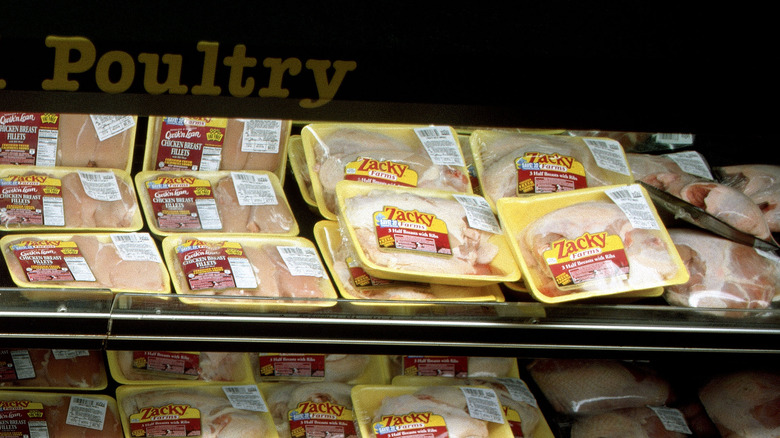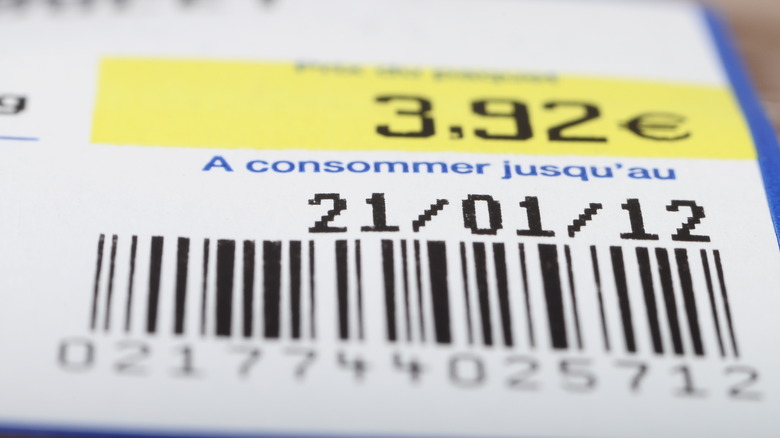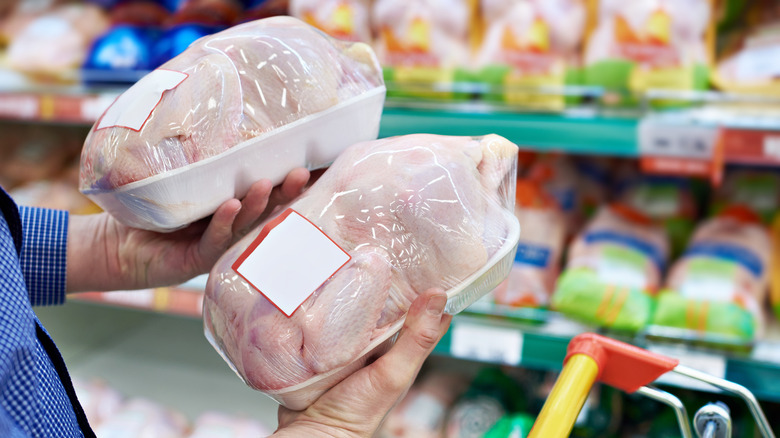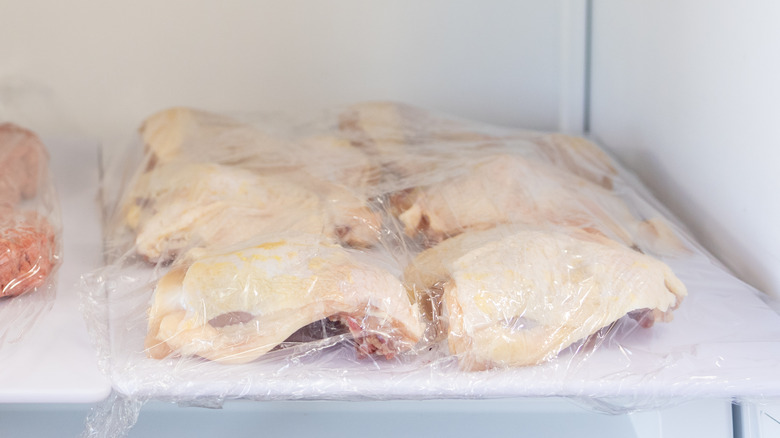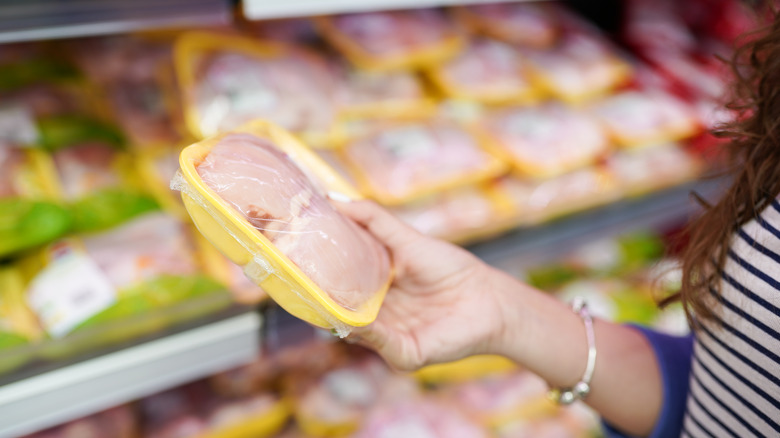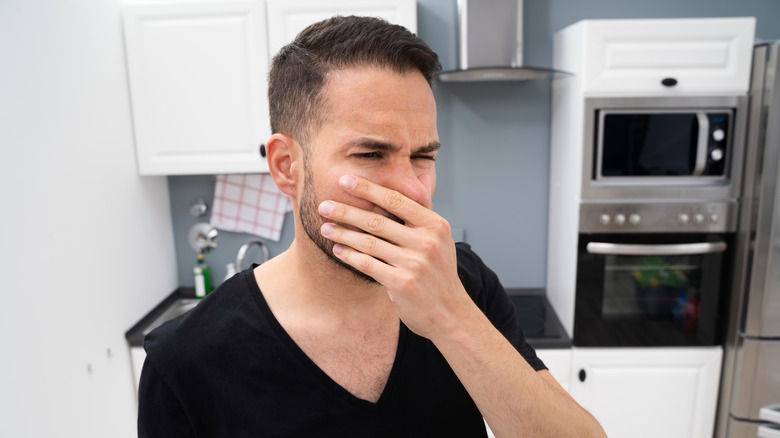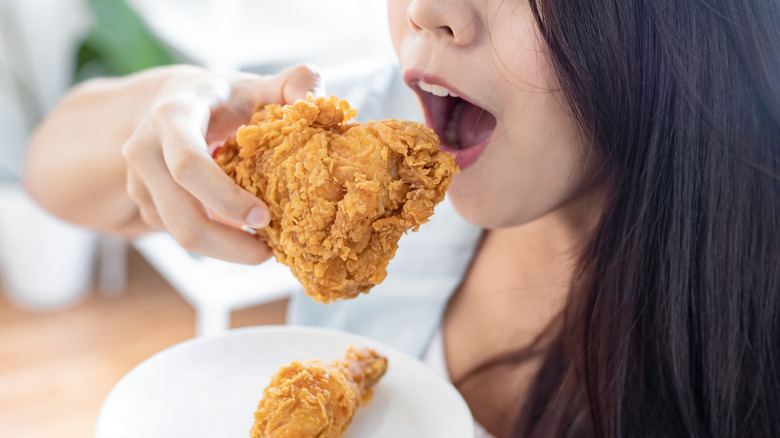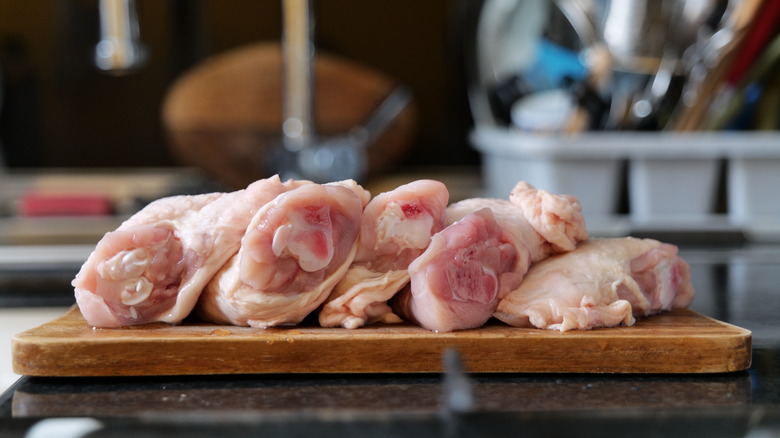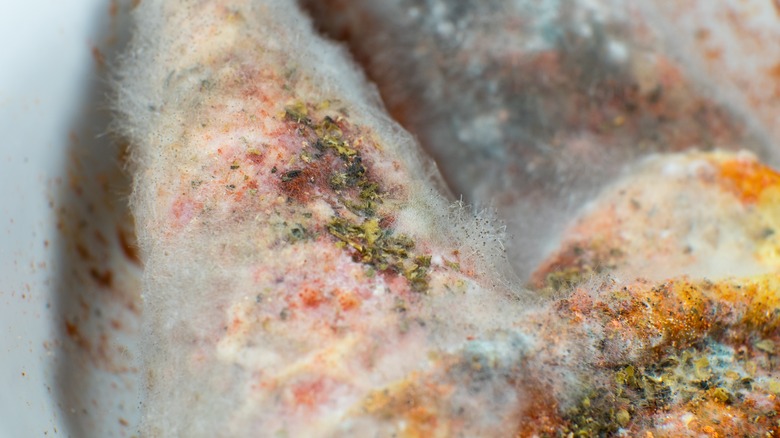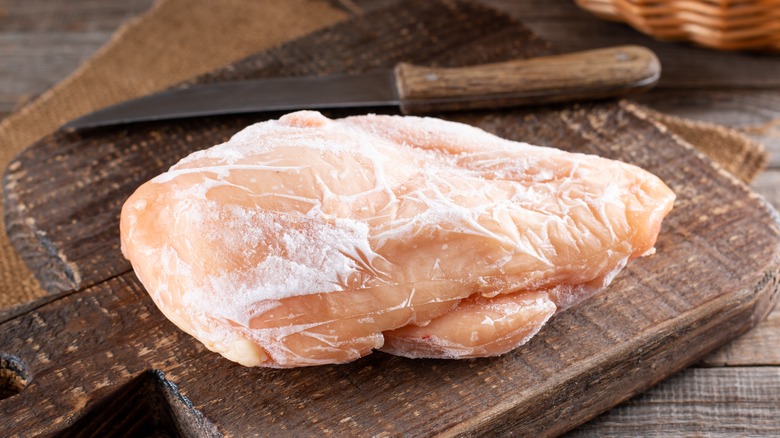10 Signs Your Chicken Has Gone Bad
Like any food, you need to make sure that your chicken is safe to eat before digging in. The Centers for Disease Control and Prevention (CDC) estimates there are roughly one million cases of poultry-related food poisoning every year. Not only that, but poultry was connected to more U.S. foodborne illness deaths than any other food commodity between 1998 and 2008 (via Emerging Infectious Diseases).
While some of these cases are due to eating raw or undercooked chicken, you also can get sick from chicken that has spoiled. Common food poisoning symptoms range from nausea and vomiting to weakness, muscle aches, chills, and even fever — and they may not start until weeks afterward. Knowing how to tell if chicken has gone bad will help avoid an experience that's unpleasant at best.
This is especially important when you consider that U.S. chicken consumption has exploded over the last 60-plus years. According to the National Chicken Council, the average American is projected to chow down on 102.3 pounds of chicken in 2024. That's an increase of 365% from the 28 pounds per person in 1960! With so many ways to enjoy chicken — from classics like fried chicken and chicken noodle soup to Cornell chicken and other more modern creations — it's no wonder people have come to love their chicken.
However, that means many more opportunities for something to go wrong. Let's look at 10 signs of spoiled chicken that will keep you and others from devouring rotten meat.
1. The purchase and expiration dates have passed
Sometimes, you don't even need to open the package to determine if your chicken is rotten. The U.S. Department of Agriculture (USDA) mandates that all thermally proceed formed of chicken, such as the lunch bowls and pouches you find at the grocery store deli, must have accurate packing dates and use-by dates. More than 20 individual states also call for at least some other form of "Open Dating" — i.e. an easily readable calendar date — on other forms of chicken
For these chicken products, the month and day must be listed along with a short description of what it refers to, such as "Sell By" or "Best if Used By." The year is also required if a product is frozen or shelf-stable. Although the chicken could still be edible after a use-by or expiration date has passed, the quality will have started to decline, so you'll want to verify whether it's still good.
Beware that some states still have few if any requirements for food dating. Should this be the case in your area, there are two things to consider. First, any date applied voluntarily must be accurate if the food is packaged under the auspices of the Food Safety and Inspection Service (FSIS). Second, regardless of the packaging date, FoodSafety.gov has issued its own recommendations for how soon to use chicken. This includes preparing raw chicken within 1-2 days of purchase when stored in the refrigerator. If you don't think you're going to use the chicken by the provided date or in this time frame, you can move it to the freezer to extend its shelf life.
2. The store packaging is damaged or shows signs of improper handling
Despite the requirements and recommendations for when to use chicken, it can still go bad before those dates arrive. When this happens, damaged or improper packaging is often the culprit. The FDA notes you should never purchase anything that has been opened, is torn, or has other signs of damage. This exposes the food to dangerous bacteria and could be a sign that it has been tampered with.
You should also avoid chicken that appears to have been thawed and refrozen or vice versa. The McGill Office for Science and Society notes that when meat or poultry is thawed out, any bacteria in the food will wake up and start multiplying again. Furthermore, each subsequent freeze/refreeze cycle can hurt the chicken's quality due to loss of moisture (via AskUSDA). Signs of thawing and refreezing include ice crystals, frostburn, a faded or gray color, and an excessively soft texture.
Finally, be wary of chicken packaging that looks bloated or swollen. Per the UK's Food Standards Agency, this could be an indicator that bacteria has already developed. Granted, this isn't always the case, as bloating sometimes happens due to high altitude or is even deliberate by the manufacturer. Regardless, the packaging usually hasn't blown up due to an explosion of flavor.
3. The chicken has been stored incorrectly at home
Being careful about chicken packaging and storage continues after you leave the market. The Michigan State University Extension says raw chicken should be kept in the refrigerator at a temperature no higher than 40 degrees Fahrenheit. (Place it on the bottom shelf so juices and drips don't cross-contaminate other food.) Remember to check your fridge is on the correct settings; we've personally lost perfectly good chicken because it turned out the settings were wrong. If you know it's going to be more than an hour before getting the chicken from the store cooler to the refrigerator, put the chicken on ice or in a cooler so it doesn't get warm.
Furthermore, as long as the chicken is in the original packaging, you should continue to be on the lookout for bloating. According to Food Safety, bloating usually comes from bacteria releasing gas, and this only occurs once the bacteria reaches a certain concentration. In other words, the bacteria could have been at safe levels when you bought the chicken but multiplied to unsafe levels before you had a chance to cook or freeze it.
Once the chicken has been removed from its packaging — whether to cook, divide, or freeze it — place the pieces in airtight sealable containers or bags. Open, air-filled containers make it much easier for microbes to thrive. When freezing chicken, keep it at the rear of the freezer, as the temperature will be steadier in this area.
4. The chicken's color has changed
Of course, even if you follow proper storage and use-by methods, chicken can still go bad. Luckily, there are other ways to tell if chicken is spoiled — and it starts with a simple glance at what the meat looks like.
Although the color of raw poultry sometimes changes based on factors such as breed and age, chef Curtis Stone says that fresh raw chicken should generally be pink and fleshy (via YouTube). Mild color changes or fading are usually safe, though the chicken quality won't be quite as good — this happens because oxymyoglobin protein was exposed to oxygen and turned into metmyoglobin. However, if the meat has started to turn a gray or greenish hue, this is a telltale clue of spoilage. Generally, the fatty pieces and skin should be cream-colored or yellow. The big thing is that the color is consistent throughout — splotches and clear signs of color change are bad things.
As for cooked chicken, you generally want it to be white all the way through, unless you specifically purchased dark meat. Technically, though, chicken that's a little pink in the center is okay if each part of the meat reaches at least 165 degrees Fahrenheit during the cooking process. Therefore, what you should look for is any sort of "off-color" that's different from when you first cooked the bird. And it goes without saying that any obvious signs of mold should mean a one-way ticket to the garbage can.
5. The texture and feel have changed
How the chicken feels is also a way to determine whether you have bad chicken on your hands. Fresh raw chicken should have a firm texture, be moist, and look plump. Meat that feels overly tough or soft is likely gone bad — or it could be "woody breast", a growing phenomenon caused by muscle irregularities (via National Chicken Council). A test you can do at the store is to press down on the raw chicken (through the packaging, of course). If the meat immediately springs back, the chicken is fresh and non-woody. If it doesn't spring back up or is hard to press down in the first place, you should avoid it.
When you do this or touch a piece of raw chicken for any other reason, it should feel cold. As for cooked chicken, it will be even more firm because of the water that has evaporated, which also makes it feel drier. In the case of both raw and cooked chicken, any sort of newfound sliminess, stickiness, or other changes to the regular texture are an instant signal that you should throw it away. Last but not least, raw chicken should be somewhat shiny. Beware of any raw poultry that looks dull or feels like it has a filmy layer on top.
6. Your chicken smells funny
How should raw chicken smell? If it's still okay to eat, it shouldn't smell like much of anything. Edith's Bistro has described the odor of raw chicken as being slightly sweet or metallic, but not overly strong. Therefore, any sort of strong or pungent smell is usually a sign of spoilage — it means enough bacteria has grown that the chicken has begun to decompose. As one Reddit commenter put it, "Bad chicken smells BAD. You'd probably know it."
That said, some of you might need more specifics, especially if we're talking about prepared chicken piled high with spices, sauces, and other add-ons that can mask odors. The biggest thing to whiff around for is an odor resembling rotten eggs or sulfur. Others have compared it to ammonia, general sourness, or dirty dish towels. Whatever the scent, it's caused by the growing concentration of spoilage bacteria — which can grow even at cold temperatures, which is why refrigerated chicken still goes bad eventually. (These same bacteria are what create the sliminess mentioned earlier.)
The smell of rotten chicken has disrupted on a large scale, too. In 2022, Costco's official chicken supplier in Nebraska started selling leftover chicken parts to area farmers as compost (via Insider). Area residents immediately began complaining about the "smell of death." Just imagine that in your fridge!
7. It tastes bad or weird
First, let's make something abundantly clear: you should never deliberately ingest chicken that shows any signs of having gone bad. This is how you end up becoming part of those one million people annually with food poisoning from poultry. Still, you may accidentally bite into some bad chicken that didn't exhibit any other symptoms of rottenness. Should this happen, the taste has been reported as resembling something acid, bitter, heavily metallic, or ammonia. If you detect those things, or anything else distinctly off from the normal taste, immediately spit the chicken out and don't eat anymore.
Why is it so vital not to eat bad chicken? It goes back to raw chicken frequently containing pathogenic bacteria such as salmonella, campylobacter and clostridium perfringens. The amounts present in fresh chicken are usually mitigated by proper food handling and cooking it to at least 165 degrees. But the longer your chicken hangs around, the more bacteria proliferate. Gizmodo points out that in the right conditions — or the wrong conditions, as it were — bacteria can double every half hour.
Campylobacter is particularly dangerous. WebMD says it has been known to cause Guillain-Barre syndrome, and the Minnesota Department of Health adds that it is responsible for the campylobacteriosis infection. It's easy to see why you should stop eating chicken at any hint of a "fowl" taste — though interestingly, the spoilage bacteria that create bad odors are far less likely to cause sickness than pathogenic bacteria.
8. It's been left out too long
We know how tempting it can be to place a package of chicken on the counter to thaw faster. It's also far too easy to let food sit for a while after dinner before putting it away. Each course of action, though, is an express one-way ticket to a rotten bird. The temperature range between 40 and 140 degrees is when bacteria develop the fastest — so much so that the USDA has dubbed this the "Danger Zone."
One of the most likely bacteria to flourish in the Danger Zone is Clostridium perfringens, which is specifically linked to poultry and meat. It's been dubbed "the cafeteria germ" because it's so common at catered events, and the CDC estimates Clostridium perfringens is responsible for nearly one million cases of food poisoning a year. The typical systems are stomach cramps, diarrhea, and dehydration.
The risk of this and other bacteria is so high that raw or cooked chicken can spoil in as little as two hours at room temperature. At temperatures above 90 degrees, such as being left in a car on a hot day, it might only take one hour. So follow proper thawing procedures and immediately put leftover chicken away after everyone has eaten their fill. If poultry has been left on the counter all afternoon or all night, the only thing that should be dining on it is the trash pail.
9. It's been in the fridge for too long
We've already discussed that the shelf life is short for raw chicken in the refrigerator. However, cooked chicken will also spoil if left in the fridge long enough. Even at the recommended 40 degrees Fahrenheit or lower, FoodSafety.gov says you should keep cooked chicken in refrigerator storage for no longer than four days. The maximum window for chicken luncheon meat is five days if the package is opened or two weeks if it's unopened.
Beyond any of these times, eating refrigerated chicken becomes increasingly dangerous because of the bacteria we mentioned earlier. This timetable is especially important to know if your leftovers have a lot of seasoning or dressing, which will cover up visual signs of chicken going bad. If you don't think you'll eat the remaining chicken in time, move it to the freezer.
What about frozen chicken that you've thawed out? As with raw chicken, the USDA gives you 1-2 days to cook or refreeze defrosted chicken — as long as you thaw it in the refrigerator and keep it there. If you use the microwave or cold water methods to defrost your chicken, you should cook it immediately. This is because they will warm your poultry up to the point of being in the "Danger Zone" we talked about previously. Therefore, immediate cooking is necessary to kill any bacteria that have formed. Any other thawing method besides the three methods is unsafe and should never be attempted unlike you somehow like spoiled chicken.
10. It's been in the freezer for too long
Frozen chicken is an interesting case. The USDA has stated that chicken and other foods continually kept frozen at zero degrees or lower remain safe to eat for infinity. These temperatures inactivate any existing bacteria or mold and make it impossible for new microbes to form.
However, the chicken's quality will eventually start to deteriorate, including loss of flavor and changes in texture. It's also possible for chicken to develop "freezer burn," which happens because there is too much air in the packaging. Freezer-burned chicken will have discolored spots with a dry leathery texture. And if the chicken is tacky, slimy, or shows any other signs of spoilage after thawing, it shouldn't be eaten regardless.
How long you can freeze chicken while retaining its quality depends on the form of the chicken. USDA recommendations include a maximum of one year for a whole chicken, nine months for chicken pieces, 3-4 months for ground chicken and giblets, four months for leftover cooked chicken, and 1-3 months for pre-cooked chicken patties or nuggets. If you think the chicken will be in the freezer longer than two months, repackage it in airtight freezer bags or containers to reduce the chances of freezer burning. You can also overwrap the store packaging with heavy-duty foil. Above all, make sure to freeze the chicken as soon as possible. The better the quality was at the time of freezing, the better it will be when you thaw it out.
